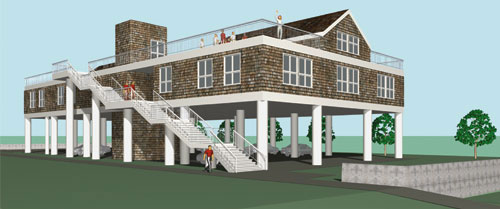 When the Sendai quake and tsunami hit last March, many Japanese residents took refuge in “vertical evacuation structures,” reinforced concrete buildings that were strong enough — and tall enough — to withstand the force of the waves. Now officials in Cannon Beach aim to build a similar tsunami-resistant structure — the first in the United States.
When the Sendai quake and tsunami hit last March, many Japanese residents took refuge in “vertical evacuation structures,” reinforced concrete buildings that were strong enough — and tall enough — to withstand the force of the waves. Now officials in Cannon Beach aim to build a similar tsunami-resistant structure — the first in the United States.
 |
The design features a 10,000-square-foot structure on concrete pillars supported by concrete piles and beams and four-foot walls in front and back. // Photo courtesy Ecola Architects, PC |
When the Sendai quake and tsunami hit last March, many Japanese residents took refuge in “vertical evacuation structures,” reinforced concrete buildings that were strong enough — and tall enough — to withstand the force of the waves. Now officials in Cannon Beach aim to build a similar tsunami-resistant structure — the first in the United States.
Raised 15 feet off the ground, the two-story building, tentatively sited at the intersection of Gower and Hemlock streets, would provide shelter for about 1,500 people and also serve as a new city hall. “The goal is to save lives and provide continuity of government,” says Jay Raskin, an architect and former mayor of Cannon Beach who is spearheading the design process.
Just 50 miles off the Oregon Coast is the Cascadia Subduction Zone, a 600-mile fault that many scientists say is overdue for a rupture, producing a massive quake and tsunami that could engulf seaside towns. “We’re going to get what Japan got and we’re in a window of it happening within our lifetime,” says Patrick Corcoran, an Oregon State University coastal outreach hazards specialist. The proposed design was developed with assistance from Oregon State University and the Department of Geology and Mineral Industries.
Several questions remain before the project can move forward. Although the conceptual plans follow guidelines from the Federal Emergency Management Agency (FEMA), there is no federal or state funding for the structure, which is expected to cost about $4 million — about twice the cost of a conventional building.
OSU researchers are also conducting an evacuation simulation study to see how effective the proposed building would be compared to a base case without the building.
Despite the uncertainties hanging over the pioneering project, Oregon needs vertical evacuation strategies, says Jennifer Chamberlain, Oregon Office of Emergency Management spokeswoman. That’s because in many areas of the coast, people won’t have time to walk — or run — to high ground before the tsunami strikes. “There is no safe haven,” says Chamberlain.


